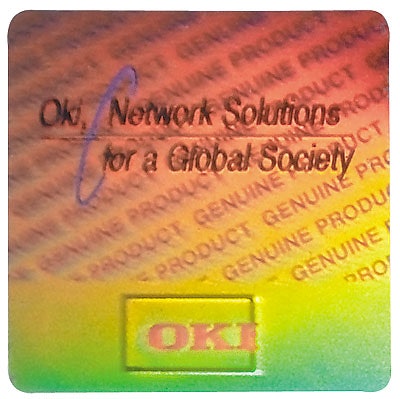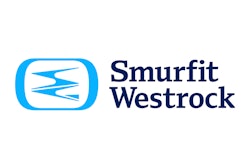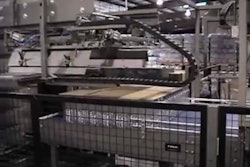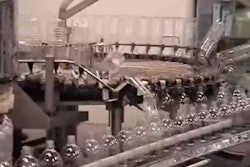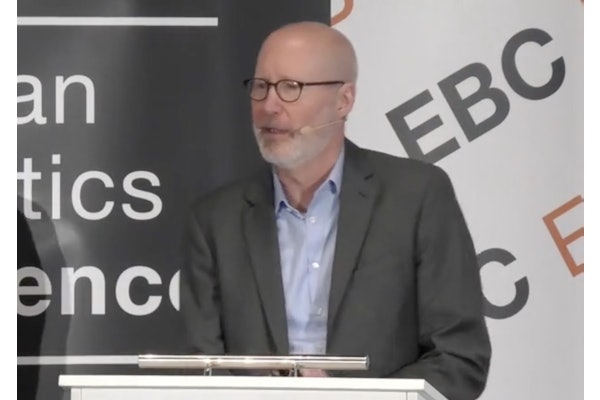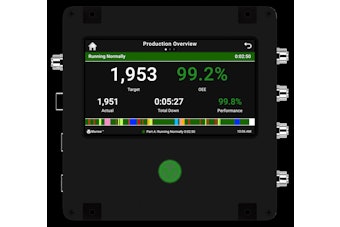Several months ago, peripheral computer equipment manufacturer Oki Data Americas, Mount Laurel, NJ, improved the product authentication for its line of printer and fax products. Consumable products, such as toner and ribbon cartridges, are now protected from counterfeiters by holographic labels supplied by Westvaco Brand Security (Stamford, CT), a wholly owned subsidiary of MeadWestvaco Corp.
“Our customers associate the Oki name with premium quality, and we must work hard to maintain their trust,” says Steve Boyd, Oki’s vice president of consumables and customer service. “WBS helps us protect the integrity of our products and secure our distribution channels.”
According to the Imaging Supplies Coalition, counterfeit and diverted products are estimated to cost the imaging supplies industry at least $1 billion annually.
The rolls of pressure-sensitive labels replace p-s labels from another supplier Oki had used before. “When we implemented our original security in 1999, we had already developed an exit strategy,” explains Lisa Boblenz, product manager, consumables. “Every company knows that, at some point, their package security will be compromised, so we’re constantly looking for new solutions to protect [our] products. This is the next generation security solution for us.”
No reader required
The WBS hologram has all the features of the previous one and more. One major improvement is that the new hologram’s authenticity can be verified in the market without the use of costly readers, specialized devices that confirm the authenticity of a particular feature. Boblenz declines to be more specific for obvious reasons.
Readers cost upwards of $500 apiece, according to Boblenz, and were required before by Oki’s distributors and sales force. “Although it’s a great way to identify your product, you don’t want to be burdened with the cost of all the readers,” she says.
The ¾’’ square holographic label is automatically affixed by label applicators to the top of paperboard folding cartons. As before, that’s done by Oki’s domestic contract packager. If it is removed from the carton, the holographic label produces a tell-tale fiber tear that is absolutely crucial, Boblenz notes. Besides the Oki logo, the hologram also carries the words “Oki, Network Solutions for a Global Society,” while the words “genuine product” repeat in the background in a 3-D effect.
Another security improvement is “Parallax,” a feature that Boblenz points out has not been counterfeited to date. When the hologram is moved, the word “Oki” appears to move around.
Although the hologram is used on 14 of the company’s best-selling products, only three of those are actually targeted by counterfeiters, Boblenz points out. “My strategy was to protect all my top products right from the start,” she explains.
The products are sold throughout the Americas. Shipments began in November, and the cartoned products began appearing at retail by early March.
Europe revisits Americas’ methods
Coinciding with Oki Data Americas’ change in security labels, Oki’s European division was similarly assessing options for its second generation of product security. In fact, the two divisions exchanged information regarding pricing and vendors. “When it came to the design and final decisions, each worked independently,” Boblenz notes.
Interestingly, Europe chose Oki Americas’ previous supplier and holographic label. “Oki Europe’s first solution had been hot-stamp technology, while ours had been the more economical pressure-sensitive labels,” Boblenz explains. “Also, our packaging vendor did not have hot-stamp capability, and we didn’t want to impose those added costs on them. We’d been happy with the vendor, but we were looking for a higher level of security.”
She was also pleased by the fact that the protective labels are procured “at a very competitive cost,” and that no added costs were passed along to consumers.
Oki welcomes publicity on the enhanced security: “We want to be very bold about the fact we’re taking the time and investing the money to ensure that our customers get what they’re paying for,” Boblenz emphasizes. “We want people to know that we’ve made a change by putting this on our packaging.
Boblenz says that they’ve done such a good job of promoting this new hologram that, “in a sense, it almost backfired,” she relates. “Store personnel came back to our Latin American distributors and said ‘I have older products [secure and untouched] in my inventory without the hologram, is it counterfeit? I want the packages with the hologram!’”
Although the holographic label is the most overt deterrent Oki uses, it isn’t the packaging’s only security feature. “There are another half-dozen covert features on the carton you’ll never find,” Boblenz points out mysteriously.
